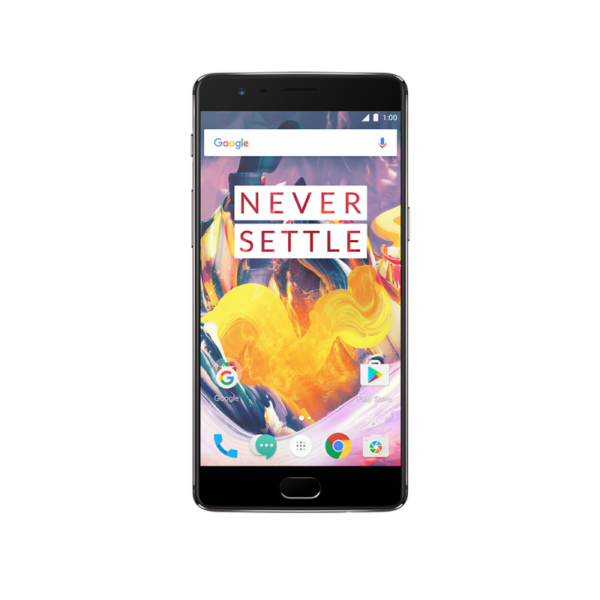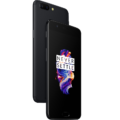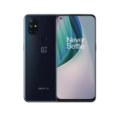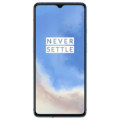- Home
- List of devices
- OnePlus
- OnePlus 3T
OnePlus 3T


-
CPU: Qualcomm Snapdragon 821
-
RAM: 6GB
-
Storage: 64GB | 128GB
-
Display: 5.5" 1080p
-
Camera: 16mp front and back
-
OS: Android 6 Marshmallow
OnePlus 3T was launched today after weeks of leaks and reports. The latest smartphone from OnePlus comes with the new Qualcomm Snapdragon 821 processor and an improved 16 MP front facing camera. The OnePlus 3T comes with Android 6.0 Marshmallow, although the company has said that the Nougat update is in the works already.
OnePlus 3T Specs
The new OnePlus 3T is more or less a semi-upgrade from the OnePlus 3. It comes with the same 5.5 inch full HD display, featuring the same Optic AMOLED technology that we saw on the OnePlus 3. It comes with Android 6.0 Marshmallow out of the box with a Nougat update already in the works.
Coming to other specs, the OnePlus 3T comes with the latest Qualcomm Snapdragon 821 SoC with a quad-core processor and Adreno 530 GPU. The Snapdragon 821 is a higher binned version of the Snapdragon 820, with a slight improvement in performance. In essence, you can expect all updates that the Snapdragon 821 receives will be pushed to the Snapdragon 820 as well.
On the memory front, the OnePlus 3T comes with 6 GB RAM. In terms of storage, you get two versions – 64 GB and 128 GB, both featuring the fast UFS 2.0 technology. There is no support for memory cards, though.
The next big improvement we see is on the camera front. The rear camera is the same as before – a 16 MP sensor with f/2.0 aperture, phase detection autofocus, optical image stabilisation and LED flash. On the front, though, is where things get interesting. OnePlus has sourced a 16 MP sensor from Samsung. So you’re getting a 16 MP sensor with f/2.0 aperture and phase detection autofocus on the front as well.
Lastly, the battery has also seen a bump. From 3000 mAh on the OnePlus 3, you now get a 3400 mAh battery on the OnePlus 3T. Dash Charge and USB Type C are also present.
Other connectivity options include dual SIM, 4G VoLTE support, Wi-Fi b/g/n/ac, Bluetooth 4.2 and NFC.
Pricing And Availability
The OnePlus 3T has been priced at $439 for the 64 GB version and $479 for the 128 GB version. At the moment, OnePlus 3T will be made available in US and Europe. Details about availability in other markets are not known yet.
Specs
General
| Price | INR 27,999 |
| Announced | 15 November, 2016 |
| Released | 02 December, 2016 |
| Status | Coming Soon |
Display
| Display Type <strong>Display Technology => </strong> A number of display technologies and types used in mobile phones => TFT (Thin Film Transistor), IPS (In-Place Switching), OLED (Organic Light Emitting Diode), AMOLED (Active-Matrix Organic Light-Emitting Diode), Super AMOLED (an even advanced version of AMOLED), Resistive Touchscreen (Resistive touchscreens contain two layer of conductive material with a very small gap between them which acts as a resistance), Capacitive Touchsceen (Capacitive touchscreen technology consists of a layer of glass coated with a transparent conductor) | LTPS |
| Size | 5.5 inches |
| Resolution | 1080 x 1920 |
| Pixel Density <strong>Pixel Density (PPI)</strong> is refers to the concentration of pixels on a particular display, measured in pixels per inch (ppi). Pixel density is calculated by dividing the diagonal pixel resolution of a display by its diagonal size, higher pixel density better display quality. | 401 ppi |
| Display Protection <strong>Display Protection => </strong> Gorilla Glass is a special alkali-aluminosilicate glass shield with exceptional damage resistance that helps protect mobile displays from scratches, drops, and bumps of everyday use, It is always better to go for a smartphone with Gorilla Glass for that added protection and peace of mind. | Corning Gorilla Glass 4 |
| Secondary Display | None |
Hardware
| Chipset <strong>Chipset</strong> is a group of integrated circuits designed to perform one or a more dedicated functions, often with real time computing constraints, Popular smartphones are equipped with more advanced embedded chipsets that can do many different tasks depending on their programming. | Qualcomm© Snapdragon™ 821 processor |
| CPU <strong>CPU</strong> (Central Processing Unit) mostly known as processors, CPU processes instructions in order to carry out certain functions that make your device operate properly. Processors are often described as the brain of computers, smartphones and tablets, Smartphones and tablets rely on processors to carry out their every task, Processors are an incredibly important factor in selecting any type of computing device, including your smartphone. | 2x 2.35 GHz Kryo & 2x 1.6 GHz Kryo |
| GPU <strong>GPU</strong> (Graphics Processing Unit) is a single-chip processor designed to rapidly manipulate and alter memory to accelerate the creation of images in a frame buffer intended for output to a display, This includes things such as lighting effects, object transformations, and 3D motion. | Adreno 530 |
| RAM (Memory) <strong>RAM</strong> (Random Access Memory) is a type of computer memory that can be accessed randomly, any byte of memory can be accessed without touching the preceding bytes that allows information to be stored and accessed quickly from random locations. RAM is the most common type of memory found in computer systems, smartphones, tablets and other electronic devices. | 6GB |
| Internal Storage <strong>Internal Storage</strong> is a data storage space (flash memory) mostly used in smartphones, tablets and other electronic devices where operating system, apps, music, photos, videos, files and other user data Is stored. | 64GB | 128GB |
| Card Slot <strong>Memory Card Slot</strong> is a special slot for inserting a memory card. Memory cards allow you to expand the phone's built-in memory, A memory card (sometimes called a flash memory card or a storage card) is a small storage medium used to store data such as text, pictures, audio, and video, for use on small, portable or remote computing devices such as mobile phones, mp3 players, digital cameras. | No |
| Sensors <strong>Sensors</strong> are electronic components that detects and responds to some type of input from the physical environment. The specific input could be light, heat, motion, moisture, pressure and location, The output is generally a signal that is converted to use in computing systems, a location sensor, such as a GPS receiver is able to detect current location of your electronic device. | Fingerprint, Accelerometer, Gyroscope, Proximity and Ambient Light, Hall, Compass |
Battery
| Battery Type <strong>Battery Type => </strong> Cell phones run on various kinds of batteries depending on the manufacturer, phone size or shape and features. There are basically four types of cell phone batteries => Lithium Polymer, Lithium Ion, Nickel Metal Hydride and Nickel Cadmium. | Li-Poly (Lithium Polymer) |
| Capacity <strong>Battery Capacity</strong> is a measure (typically in Amp-hr) of the charge stored by the battery, and is determined by the mass of active material contained in the battery. The battery capacity represents the maximum amount of energy that can be extracted from the battery under certain conditions. | 3450mAh |
| Fast Charging | Yes, 5V,4A |
| Wireless Charging <strong>Wireless Charging</strong> (Inductive Charging) uses an electromagnetic field to transfer energy between two objects. This is usually done with a charging station. Energy is sent through an inductive coupling to an electrical device, which can then use that energy to charge batteries or run the device. | No |
Camera
| Primary <strong>Camera</strong> is able to capture photographs and usually videos, The most important characteristics of a camera are the resolution (measured in megapixels), lens focus type (fixed or automatic), higher megapixel cameras are known to capture higher quality photos, but not always a good measurement of the photos quality. | 16mp |
| Camera Features |
f/2.0 Optical Image Stabilization PDAF 1.12 µm pixel size |
| Secondary | 16mp Samsung 3P8SP sensor |
| Video | Up to 4K resolution |
| Flash <strong>Flash Light => </strong> There is commonly two types of flash lights are used in camera mobile phones, LED Flash (LED flash offers lower power consumption with drive circuitry that takes up very little room, LEDs can be strobed faster than any other light source), Xenon Flash (xenon flash produces an extremely intense full-spectrum white light for a very short duration) | Dual LED |
Design
| Type <strong>Design Type</strong> called form factor refers to a mobile phone's size, shape, and style as well as the layout and position of major components of phone. There are three major form factors seen in mobile phones => bar phones, folding phones and sliding phones. | Bar |
| Dimensions | 152.7 x 74.7 x 7.35 mm |
| Weight | 158 grams |
| Protection | Gorilla Glass 4 |
| Colors | Gunmetal / Soft Gold |
Network
| SIM <strong>SIM</strong> (Subscriber Identity Module) is a small card that contains mobile network subscriber's account information. This allows the phone using the card to attach to a mobile network. The SIM card is most commonly associated with GSM and UMTS mobile networks. Moving a SIM card from one phone to another allows a subscriber to switch mobile phones without having to contact their mobile network carrier. SIM cards can also be used by a phone to store limited amounts of data, such as phone numbers and text messages. | Nano SIM |
| VoLTE Support for VoLTE | |
| Dual SIM | Yes |
| 2G Network | GSM: 850, 900, 1800, 1900 MHz |
| 3G Network | HSDPA 850 / 900 / 1900 / 2100 |
| 4G Network |
FDD-LTE: Bands 1/3/5/7/8/20 TDD-LTE: Bands 38/40 |
Software
| Operating System <strong>OS => </strong> Every computer system run on a base software called Operating System (OS). Operating System controls all basic operations of the computer (such as smartphone, PDAs, tablet computers and other handheld devices). The Operating System allows the user to install and run third party applications (apps), apps are used to add new functionality to the device. | Android 6 Marshmallow |
| User Interface <strong>UI</strong> or user interface of a device is the look and feel of the on-screen menu system. How it works, its color scheme, how it responds to button presses, all of these things are part of the user interface. | Oxygen UI |
Connectivity
| Bluetooth <strong>Bluetooth</strong> is a wireless communications technology for exchanging data between mobile phones, headsets, computers and other network devices over short distances without wires, Bluetooth technology was primarily designed to support simple wireless networking of personal consumer devices. | v4.2 |
| Infrared <strong>Infrared</strong> connectivity is an old wireless technology used to connect two electronic devices. It uses a beam of infrared light to transmit information and so requires direct line of sight and operates only at close range. | |
| Wi-fi <strong>Wi-Fi</strong> is a popular wireless networking technology using radio waves to provide high-speed network connections that allows devices to communicate without cords or cables, Wi-Fi is increasingly becoming the preferred mode of internet connectivity all over the world. | 802.11 b/g/n/ac |
| USB | 2.0 Type-C |
| GPS <strong>GPS</strong> The Global Positioning System is a satellite-based radio navigation system, GPS permits users to determine their position, velocity and the time 24 hours a day, in all weather, anywhere in the world, In order to locate your position, your device or GPS receiver must have a clear view of the sky. | Yes |
| NFC <strong>NFC</strong> (Near field communication) is a set of standards for smartphones and similar devices to establish peer-to-peer radio communications with each other by touching them together or bringing them into proximity, usually no more than a few inches. |



